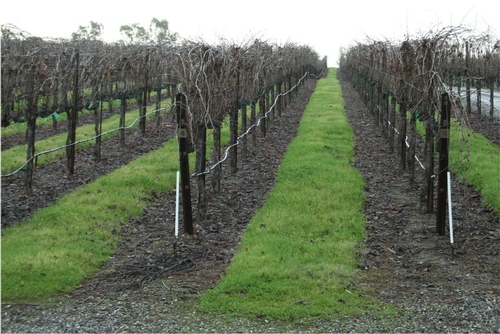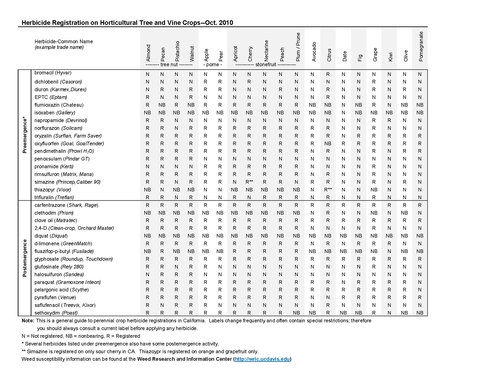Reposted from a paper presented at the 59th annual Lodi Grape Day (February 1, 2011).
Brad Hanson, Cooperative Extension Weed Specialist, UC Davis
What makes a weed a weed? Better yet, what makes a weed a "tough weed"? Or even better still, what makes a tough weed tough to control? Confused yet?
One definition of agricultural weeds that I like is "a plant that is especially successful at colonizing and proliferating in disturbed, but potentially productive areas". Most vineyards fall into the category of "disturbed, but productive" since we usually have adequate water and fertility within the vine row and routinely mow, spray, or mechanically remove weedy plants from the strips or across the field. Successful weeds can quickly reinfest these areas and "tough" weeds often manage to avoid or survive our control measures.
Each year, growers and land managers make weed control decisions with the goal of minimizing the impact of weeds on crop productivity, fruit quality, and operational efficiency all while minimizing the environmental impact of their choices and maintaining the economic viability of their operation. There are several important factors to consider during the process.

Proper Weed Identification
No skill is more important to effective weed control than proper weed identification. There is an old saying that, "if all you have is a hammer, everything looks like a nail". In weed control, you can turn that quote around and think "if all your problems look like nails, you’ll always try to solve them with a hammer".
The most recent weed identification book for California ("Weeds of California and other Western States" by DiTomaso and Healy) describes 450 important weeds and another 360 similar species that occasionally are weedy. However, vineyard managers and other crop producers face only a small fraction of these weeds in any field in any year. In reality, almost half of those important weeds fall in just three families; the sunflower family (Asteraceae), grasses (Poaceae), and mustards (Brassicaceae). Developing an understanding of weed identification can help managers make better decisions on management of their specific weed problems.
Responding to shifting weed problems
Not all weed control techniques work equally well on all weeds and different species respond differently to control tactics (annuals vs perennials; broadleaf vs grasses; herbicide susceptible vs resistant; etc). Established vineyards rarely have "tough" weed problems that include more than one or two weed species. Typically, the weed populations have shifted in response to a particular weed management strategy. Over time, the population in the field has become dominated by species or biotypes that are not controlled by the primary weed control tactic. Remember what Einstein’s said about insanity ("Insanity is doing the same thing over and over and expecting different results")? These tough weeds are not "super weeds"; they are just not susceptible to your current management practices so you need to change strategies. Regular scouting, record keeping, proper weed identification, and a flexible and responsive management strategy should be used to stay ahead of these shifts before they become major headaches.
Evaluating weed control options
Primary weed control tactics used in vineyards include mechanical methods (ie. tillage and mowing) and chemical methods (strip or broadcast herbicides). However, consideration of integrated pest management approaches (http://www.ipm.ucdavis.edu/PMG/selectnewpest.grapes.html) should be used to take advantage of cultural tactics that can reduce the weed pressure. Some of these occur before a vineyard is planted (fumigation, field preparation, and perennial weed eradication) but many occur throughout the life of the vineyard including fertilizer amount and placement, irrigation management, cover crop selection and management, and any other cultural practice that can be manipulated to disfavor weeds.
Chemical weed control options for vineyards vary among regions, vineyard age, and grower preference (Table). When making herbicide choices several factors are typically considered:
- Weed spectrum present in the field (what species are you trying to control?)
- Required weed control duration (are you concerned primarily with winter weeds or do you need season-long control?)
- Economics and damage thresholds (long and short term considerations of weed pressure and application costs)
- Herbicide resistant weeds (preventing or managing)
- Ground and surface water quality considerations (some herbicides are restricted regionally or temporally to minimize water quality problems)
- Air quality (some herbicides have high or low Volatile Organic Compound content and are likely to be restricted more in the future)
- Worker and applicator safety (Caution, Warning, Danger signal words)
- Available equipment (spraying, tillage, mowing; what are your options?)
- Vine sensitivity to herbicide
Mechanical weed control measures also require a number of considerations:
- Weed spectrum (perennials vs annuals; winter vs summer weeds; grasses vs broad leaf)
- Cost (equipment, operator, fuel, time)
- Erosion considerations
- Carbon footprint (environmental quality concern – tillage and fuel impacts)
- Water and air quality (sediment in runoff, PM10)
- Mechanical injury to vines
Regardless of which weed management strategy or strategies are used in a vineyard, weed managers should develop an understanding of weed identification and biology as well as the benefits and drawbacks of various weed control options. Monitoring weed populations and management success and adjusting your strategy accordingly will likely result in much more satisfactory weed control, minimized environmental harm, and increased vineyard profitability over the long term.
Herbicide registration chart available online at: http://ucanr.org/blogs/UCDWeedScience/blogfiles/5320.pdf or

Weed Research and Information Center: http://wric.ucdavis.edu/
UC IPM – Grape Weeds: http://www.ipm.ucdavis.edu/PMG/r302700111.html
Attached Files: